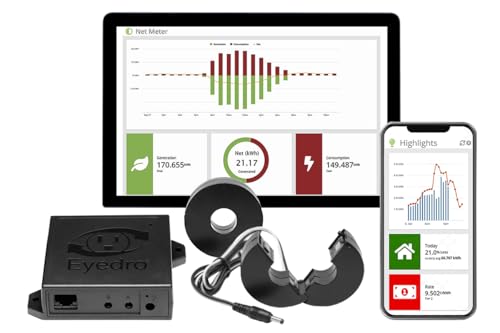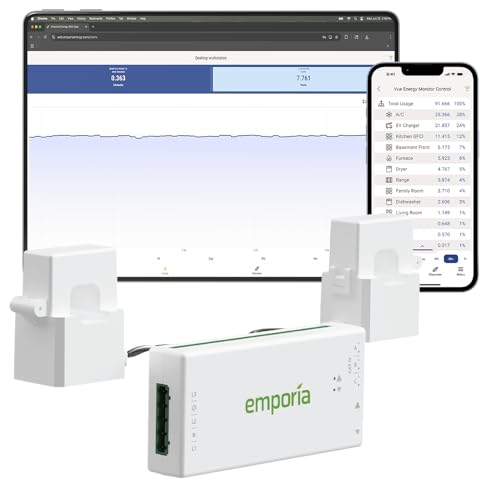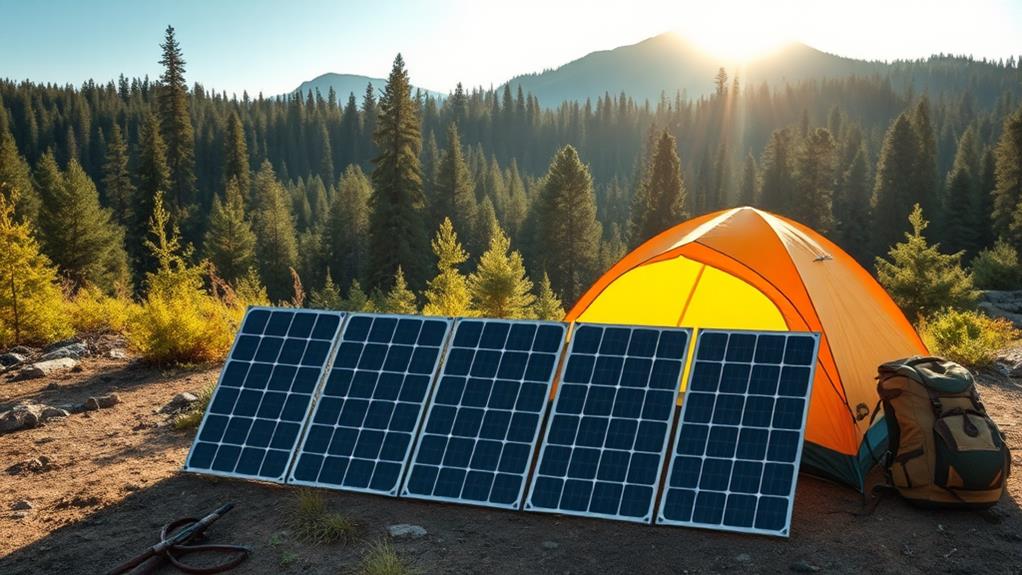To maximize your solar power output in 2025, consider investing in one of the top solar energy monitoring devices. Options like the Sense Energy Monitor with Solar, Eyedro Home Energy Monitor, and Emporia Gen 3 Smart Home Energy Monitor offer real-time tracking of electricity usage and solar production. These devices provide extensive monitoring capabilities, including time-of-use rate plan support, net metering features, and customizable notifications. With accuracy levels of ±1% to ±2%, they enable precise energy management and potential savings of 20-40%. Installation complexity varies, but most offer user-friendly configurations and remote access via mobile apps. Further exploration will reveal additional features and specifications to help you select the ideal device for your needs.
Key Takeaways
- Solar energy monitoring devices track both production and consumption, offering real-time insights to maximize power output.
- Top devices like Sense Energy Monitor and Emporia Gen 3 provide accurate, comprehensive data with mobile app integration.
- Features to look for include high accuracy (±1-2%), multiple sensor support, and compatibility with existing solar setups.
- Installation complexity varies; some devices may require professional help, while others offer user-friendly setup processes.
- Long-term value includes potential energy savings of 20-40% through optimized consumption and support for time-of-use rate plans.



Sense Energy Monitor with Solar – Track Electricity Usage and Solar Production
- SENSE SAVES: Sense saves you energy and money by providing insight into your home's energy use and activity. NOW SUPPORTING TIME-OF-USE RATE PLANS.
- MAXIMIZE YOUR SOLAR ENERGY USE: Compare solar production and energy consumption side-by-side in a single view so you can maximize the power you make...
- SEE WHAT’S UP. KNOW WHAT’S ON: Track how much electricity you’re using, what time your kids got home, or when someone leaves the basement light...
Last update on 2025-10-20 / Affiliate links / Images from Amazon Product Advertising API
The Sense Energy Monitor with Solar is an ideal choice for homeowners in the United States and Canada who want to track their electricity usage and solar production in real time. This ETL/Intertek-certified device offers thorough energy management features, including support for time-of-use rate plans and side-by-side comparisons of solar production and energy consumption. With its ability to monitor electricity use patterns and identify when family members arrive home or leave lights on, the Sense Energy Monitor provides valuable insights for optimizing energy efficiency.
The system includes a 10-watt monitor, power cable, two sets of current sensors, mounting bracket, and antenna, operating on 120-240 volts. Users can set custom notifications for critical devices, such as sump pumps or well pumps, ensuring prompt alerts for potential issues. With a customer rating of 3.9 out of 5 stars and ranking as #18 in Home Automation Modules, this device offers a robust solution for homeowners seeking to maximize their solar energy utilization and reduce overall energy costs.
Best For: Homeowners in the US and Canada who want to optimize their energy usage, track solar production, and reduce electricity costs.
Pros:
- Real-time monitoring of electricity usage and solar production
- Customizable alerts for critical devices and energy patterns
- Supports time-of-use rate plans for better energy management
Cons:
- Not available outside the United States and Canada
- Requires professional installation due to hard-wired power source
- Some users may find the 3.9-star rating less than ideal for a home automation device
Eyedro Home Energy Monitor (Ethernet or WiFi)
- DISCOVER HOW MUCH MONEY YOUR ELECTRICITY IS COSTING YOU IN REAL-TIME. With the MyEyedro cloud software you can see your usage change as you turn your...
- MONITOR YOUR SOLAR or GRID USAGE with the EYEDRO-HOME and its 2 x 200A Sensors (Add a 2nd EYEDRO-HOME system to monitor solar and grid usage as well...
- CONNECTION OPTIONS - by WiFi or Ethernet NEED HELP? Reach out to Eyedro's Technical Support Team for assistance with the setup of your Eyedro device.
Last update on 2025-10-20 / Affiliate links / Images from Amazon Product Advertising API
For solar energy enthusiasts seeking extensive monitoring capabilities, Eyedro’s Home Energy Monitor stands out with its support for solar and net metering. The EYEDRO-HOME system, available in Ethernet or WiFi (2.4 GHz) variants, offers real-time electricity usage monitoring through MyEyedro.com. With its inclusion of two 200A sensors, the device provides thorough data on watts, amps, volts, power factor, and cost. Installation requires access to the load panel, where users attach sensors to power mains and connect to the EYEDRO box. The cloud-based MyEyedro software, included without subscription fees, features a robust reporting suite with highlights, insights, live usage, and phantom energy tracking. Users can customize CT direction reversal for installation error correction and benefit from special features like appliance start-up spike detection and power/network failure notifications.
Best For: Solar energy enthusiasts and homeowners seeking comprehensive real-time electricity monitoring with support for net metering and detailed energy consumption insights.
Pros:
- Supports solar and net metering with 2 x 200A sensors for thorough monitoring
- Cloud-based MyEyedro software included without subscription fees
- Offers extensive reporting features including phantom energy tracking and cost calculators
Cons:
- Installation requires opening the load panel and electrical knowledge
- Some users report login issues on the mobile site
- Lacks deeper insights or advanced app functionality compared to some competitors
Emporia Gen 3 Smart Home Energy Monitor
- SAFETY YOU CAN TRUST WITH UL CERTIFICATION: With Emporia Energy, your home energy monitoring is safe, reliable, and certified. The Emporia Vue is UL...
- INSTALLS IN CIRCUIT PANEL of most homes with clamp-on sensors. Supports Single phase, Single-split phase, and 2-wire systems. 3-wire systems; 3-phase,...
- 24/7 ENERGY MANAGEMENT AND MONITORING: Automate, manage and control your home's real power anywhere, anytime to prevent costly repairs, conserve...
Last update on 2025-10-20 / Affiliate links / Images from Amazon Product Advertising API
Solar power enthusiasts seeking thorough energy management will find the Emporia Gen 3 Smart Home Energy Monitor a game-changer. This device, which installs in your circuit panel using clamp-on sensors, supports various electrical configurations, including single-phase and three-phase systems with additional sensors. You’ll benefit from real-time tracking of electricity usage and solar/net metering, with data collected at 1-second intervals for 3 hours, 1-minute intervals for 7 days, and 1-hour intervals indefinitely. The Emporia Energy App allows you to automate energy management, configure settings for time of use, peak demand, and excess solar, potentially lowering your electric bills. With ±2% accuracy and support for up to sixteen additional branch sensors, you can monitor specific appliances and optimize your energy consumption. The device requires 2.4 GHz WiFi and offers data export capabilities through the app.
Best For: Solar power enthusiasts and homeowners looking for comprehensive energy management, real-time monitoring, and cost-saving automation features.
Pros:
- Accurate real-time energy tracking with extensive data retention and export capabilities
- Supports various electrical configurations and allows monitoring of specific appliances
- Automation features for optimizing energy usage and potentially lowering electric bills
Cons:
- Requires professional installation in the circuit panel, which may be intimidating for some users
- Additional sensors needed for three-phase systems and specific appliance monitoring are sold separately
- Limited to 2.4 GHz WiFi, which may not be ideal for all home network setups
Sense Energy Monitor – Track Electricity Usage in Real Time
- SENSE SAVES: Sense saves you energy and money by providing insights into your home's energy use and activity. NOW SUPPORTING TIME-OF-USE RATE PLANS.
- SEE WHAT'S UP. KNOW WHAT'S ON: Track how much electricity you're using, what time your kids got home, or when someone leaves the basement light on....
- MONITOR YOUR HOME'S ENERGY USE FROM ANYWHERE: Real-time data through our iOS, Android, and web apps.
Last update on 2025-10-20 / Affiliate links / Images from Amazon Product Advertising API
Energy-conscious homeowners seeking real-time insights into their electricity usage will find the Sense Energy Monitor a powerful ally. This ETL/Intertek certified device, designed for installation inside electrical panels, offers thorough tracking of power consumption through iOS, Android, and web applications. Supporting time-of-use rate plans and providing custom notifications for critical devices, Sense aims to help users save money and energy by identifying usage patterns and inefficiencies.
Installation requires electrical expertise, with options for two separate breakers or piggybacking on existing ones. While the initial setup and device detection can be time-consuming, taking up to a month for accuracy, users generally report superior performance compared to alternatives like TED Pro Home or Efergy. However, limitations in appliance identification and occasional lag in real-time data have been noted. The 60-day warranty and mixed manufacturing locations may raise concerns for some consumers.
Best For: Energy-conscious homeowners and businesses seeking detailed, real-time insights into their electricity usage patterns and potential cost savings.
Pros:
- Provides comprehensive real-time electricity usage data accessible via mobile and web apps
- Supports time-of-use rate plans and custom notifications for critical devices
- Generally outperforms alternative energy monitors in terms of reliability and accuracy
Cons:
- Initial device detection can be slow and inaccurate, taking up to a month for optimal performance
- Installation requires electrical expertise and may pose challenges for some users
- Short 60-day warranty and mixed manufacturing locations may raise concerns about long-term reliability
SIEMENS Inhab Smart Home Energy Monitor
- ENERGY MONITOR WITH MOBILE APP (USA and Canada ONLY) – Track current and historical home energy usage 24/7 in real time with the Inhab Smart Home...
- PERSONALIZED ENERGY NOTIFICATIONS – Set custom alerts to stay informed of energy savings opportunities and abnormal behavior such as an oven left on
- WHOLE HOME AND CIRCUIT LEVEL MONITORING – Installs in new and existing electrical panels. The Inhab energy monitor doesn’t guess how much energy...
Last update on 2025-10-20 / Affiliate links / Images from Amazon Product Advertising API
Homeowners seeking extensive energy insights will find the SIEMENS Inhab Smart Home Energy Monitor a powerful ally. This USA-made device, model INHEM1216, offers thorough monitoring capabilities, tracking energy usage at both whole-home and individual circuit levels. With 16 x 50A circuit sensors and 2 x 200A main sensors, it provides real-time data on up to 16 branch circuits, accessible 24/7 via a mobile app. The monitor’s advanced features include Time of Use Management, Peak Demand Management, and Excess Solar Management, making it ideal for solar-equipped homes. It’s compatible with both new and existing electrical panels, connecting directly to critical circuits such as HVAC systems and EV chargers. UL Listed and CE marked, the SIEMENS Inhab guarantees compliance with safety standards while delivering personalized notifications for energy-saving opportunities and abnormal usage patterns.
Best For: Homeowners who want comprehensive energy monitoring, especially those with solar panels or electric vehicles, seeking to optimize their energy usage and reduce costs.
Pros:
- Detailed whole-home and circuit-level energy monitoring for up to 16 circuits
- Advanced features like Time of Use Management and Excess Solar Management
- Compatible with both new and existing electrical panels
Cons:
- Relatively expensive compared to simpler energy monitors
- Limited to use in the USA and Canada only
- May require professional installation for optimal setup and safety compliance
Smart Energy Monitor with WiFi and Real-Time Electricity Metering
- Meter Monitoring: This device can monitor two-way energy consumption, if there is Solar PV System in the user's home, after installed according to our...
- Mobile App Control: Once connected to WiFi, users can monitor device status anytime, anywhere via the Tuya or SMART LIFE app.
- Current Transformer: Equipped with a 80A current transformer CT clamp sensor, this intelligent electric monitor boasts a measurement range of 80A for...
Last update on 2025-10-20 / Affiliate links / Images from Amazon Product Advertising API
For tech-savvy consumers seeking real-time insights into their electricity usage, the Smart Energy Monitor with WiFi and Real-Time Electricity Metering is a standout choice. This single-phase clamp electricity meter, manufactured by EdgeAnt, features two 80A current transformers and provides extensive monitoring capabilities. With dimensions of 2.3 x 3.5 x 4.69 inches and weighing just 9.6 ounces, it’s a compact yet powerful device that updates data every 2 seconds with ±2% accuracy.
You’ll appreciate its ability to monitor voltage, current, and power factor for various appliances, including air conditioners and water heaters. The device requires a 2.4 GHz WiFi connection for smartphone app monitoring and is compatible with other Tuya devices via the SmartLife app. Installation is straightforward, involving attaching the clamp to the power cable, but should be performed by qualified personnel for safety reasons. With an average rating of 4.5 out of 5 stars, this monitor offers a reliable solution for those looking to optimize their energy consumption.
Best For: Homeowners and tech enthusiasts who want to monitor and optimize their electricity usage in real-time with accurate, easy-to-access data.
Pros:
- High accuracy (±2%) with frequent data updates every 2 seconds
- Easy installation and compatibility with other Tuya devices
- Comprehensive monitoring of voltage, current, and power factor for various appliances
Cons:
- Requires 2.4 GHz WiFi, which may limit placement options
- Installation should be done by qualified personnel, potentially adding to setup costs
- Limited customer reviews (only 13 ratings), making it harder to gauge long-term reliability
AC Current Voltage Power Panel Meter with LCD Digital Display
- 1. Digital Multimeter:This power energy meter can measure and display voltage current active power energy frequency and power factor at the same...
- 2. Overload Alarm function:Backlight and power will flash simultaneously to give an alarm when exceeding the preset value.You can preset power limit...
- 3. Automatic Data Storage Function:The last test data is stored automatically when the power supply abruptly lose. Don't worry about data loss due to...
Last update on 2025-10-20 / Affiliate links / Images from Amazon Product Advertising API
Solar enthusiasts seeking detailed power monitoring will find the AC Current Voltage Power Panel Meter an indispensable tool. This digital multimeter simultaneously measures voltage, current, active power, energy, frequency, and power factor, providing extensive data for your solar setup. The device features a split current transformer (CT) for easy installation, an overload alarm with customizable power limits, and automatic data storage to prevent loss during power outages. You’ll appreciate the large LCD display with a 180° viewing angle and optional blue backlight, controlled by a single button that also resets energy and sets alarm limits.
Installation requires basic electronics knowledge, as you’ll need to wire the meter and verify proper voltage supply. The split CT clamps around the live wire, and you may need to extend wires for specific applications. While the manual includes wiring diagrams, some users find them confusing, so careful study is advised. The meter’s accuracy is commendable, with users reporting precise measurements of power consumption in various settings, including RVs and solar arrays.
Best For: Solar enthusiasts and electrical DIY-ers who need detailed power monitoring and are comfortable with basic wiring.
Pros:
- Comprehensive measurements including voltage, current, power, energy, frequency, and power factor
- Large, easy-to-read LCD display with adjustable backlight and wide viewing angle
- Automatic data storage to prevent loss during power outages
Cons:
- Installation requires basic electronics knowledge and may be challenging for beginners
- Manual and wiring diagrams can be confusing and lack clarity
- May require additional wiring or custom housing for optimal setup and protection
Factors to Consider When Choosing a Solar Energy Monitoring Device

When selecting a solar energy monitoring device, you’ll need to evaluate several critical factors to guarantee peak performance and functionality. These factors include compatibility with your existing solar system, the accuracy and precision of data collection, real-time monitoring capabilities, ease of installation and setup, and remote access and control features. By carefully assessing these aspects, you’ll be able to choose a monitoring device that aligns with your specific needs, provides reliable insights into your solar energy production, and allows for efficient system management.
Compatibility With Solar System
Choosing the right solar energy monitoring device hinges on its compatibility with your existing solar system. You’ll need to verify the device aligns with your system’s configuration, whether it’s single-phase or three-phase. This compatibility directly impacts the installation process and the device’s ability to accurately monitor your solar energy production.
When selecting a monitoring solution, check that it supports net metering and solar production tracking. These features are essential for obtaining a thorough view of both your energy generation and consumption patterns. Additionally, confirm that the device can seamlessly integrate with your current electrical infrastructure without requiring major modifications, thereby simplifying installation and ongoing maintenance.
If you’re planning to monitor multiple aspects of your solar system, such as inverter output and battery storage, opt for a device that accommodates multiple sensors. This flexibility allows for a more granular analysis of your system’s performance. Finally, prioritize monitoring devices that offer real-time data capabilities. This feature provides immediate insights into your solar energy production and consumption, enabling you to make informed decisions about energy usage and system optimization.
Data Accuracy and Precision
Beyond compatibility, the accuracy and precision of data provided by solar energy monitoring devices are essential factors in your decision-making process. When evaluating potential devices, you’ll want to focus on models offering accuracy levels of ±1% to ±2%, as these notably impact your ability to gain meaningful insights into energy consumption and calculate potential savings. Real-time data updates are vital for immediate feedback, with some high-performance monitors providing updates as frequently as every 2 seconds, enabling you to make prompt adjustments to your energy usage habits.
Consider the historical data retention capabilities of each device, as they vary widely. Look for monitors that offer detailed data storage for specific intervals, such as 1-second intervals for 3 hours or 1-minute intervals for 7 days, allowing for thorough trend analysis. Additionally, prioritize devices capable of detecting appliance start-up spikes and monitoring phantom energy usage, as these features contribute to a more nuanced understanding of your consumption patterns. Be aware that accurate device detection and identification can be challenging, with some models struggling to identify specific appliances, potentially leading to inaccuracies in reported energy usage.
Real-Time Monitoring Capabilities
Real-time monitoring capabilities are an important factor in selecting the right solar energy monitoring device. These systems allow you to track electricity usage and solar production simultaneously, providing valuable insights into your energy consumption patterns and optimization opportunities. With high accuracy, typically within ±2%, effective real-time monitoring guarantees reliable readings for precise energy management. You’ll benefit from customizable notifications for vital devices, alerting you to changes in energy usage or potential issues, thereby enhancing proactive management of your solar system.
Data updates occur at frequent intervals, often every few seconds, enabling you to make immediate adjustments to your energy consumption behaviors. This rapid feedback loop is essential for optimizing your solar energy utilization. Many cloud-based monitoring solutions offer access to real-time data via mobile apps or web interfaces, facilitating easy monitoring from anywhere at any time. When evaluating solar energy monitoring devices, prioritize those with robust real-time capabilities, as they’ll provide you with the most up-to-date and actionable information. Consider the update frequency, accuracy of readings, and accessibility of data when making your selection to guarantee you’re getting the most thorough and responsive monitoring solution for your solar energy system.
Installation and Setup Ease
When it comes to selecting a solar energy monitoring device, installation and setup ease should be at the top of your list of considerations. The complexity of installation processes varies considerably among devices, with some requiring professional assistance while others can be installed by users with basic electrical knowledge. You’ll need to assess your comfort level with electrical work, as many devices require access to electrical panels, often involving opening load panels and attaching sensors directly to power mains.
For a smoother setup experience, look for devices with user-friendly configurations, such as mobile app registrations or Bluetooth connections. These features can simplify the initial setup steps. However, be prepared for potential delays in device detection, as some models may require several weeks to achieve peak performance. It’s essential to choose a device with clear, detailed installation manuals, as users have reported confusion due to unclear wiring diagrams and instructions specific to different electrical setups. When evaluating options, consider your technical expertise, the complexity of your solar system’s electrical configuration, and the level of support provided by the manufacturer to guarantee a successful installation and setup process.
Remote Access and Control
Once you’ve successfully installed your solar energy monitoring device, the next key feature to contemplate is remote access and control. This functionality empowers you to monitor real-time electricity usage and solar production from anywhere, considerably enhancing your ability to manage energy consumption effectively. Many devices offer mobile applications that provide instant notifications and alerts for critical events, enabling proactive management of your system’s performance.
Cloud-based monitoring systems often come with no subscription fees, offering a cost-effective solution to access your energy data remotely without ongoing expenses. You’ll benefit from customizable reporting features accessible via remote platforms, allowing you to track energy trends and savings over time, which aids in informed decision-making. Compatibility with WiFi networks ensures that you can effortlessly connect your monitoring device to the internet for seamless remote data access and management. When selecting a solar energy monitoring device, prioritize those with robust remote access capabilities, user-friendly interfaces, and thorough data visualization tools. These features will enable you to maximize your system’s efficiency, identify potential issues promptly, and optimize your energy consumption patterns for greater savings and sustainability.
Energy Consumption Tracking Features
Effective energy consumption tracking is a fundamental aspect of any top-tier solar energy monitoring device. When evaluating these systems, you’ll want to prioritize features that provide real-time electricity usage data, allowing for continuous monitoring of consumption patterns. This granular insight is essential for optimizing your energy efficiency and identifying potential areas for improvement.
Look for devices that offer simultaneous tracking of solar production and energy consumption, as this functionality is necessary for maximizing the benefits of your solar investment. In addition, seek out systems with customizable notifications for important devices, ensuring you’re promptly alerted to any unusual energy usage or potential issues. The ability to generate thorough reports and insights is another crucial feature, as it enables you to identify energy-intensive appliances and adjust your usage accordingly. Moreover, compatibility with time-of-use rate plans can greatly influence your utility costs by allowing you to manage consumption during peak and off-peak hours. By selecting a monitoring device with these advanced tracking capabilities, you’ll be well-equipped to make informed decisions about your energy usage, potentially leading to considerable cost savings and improved overall efficiency.
Cost and Long-Term Value
Beyond the initial features and capabilities, it’s vital to reflect on the cost and long-term value when choosing a solar energy monitoring device. The upfront investment can range from $100 to $500, depending on the device’s sophistication and functionality. However, it’s important to assess the potential long-term savings these devices can generate. Many monitoring systems can help you identify energy consumption patterns, enabling you to optimize usage and potentially reduce your electricity expenses by 20-40%.
When evaluating long-term value, prioritize devices with cloud-based monitoring and mobile access. These features provide real-time data and insights, empowering you to make informed decisions about your energy consumption. Additionally, look for devices that support time-of-use rate plans, as they can notify you of peak usage periods and encourage load shifting, further maximizing your savings. To protect your investment, opt for a device with a thorough warranty and reliable customer support. This will safeguard you against unexpected issues and potential additional costs. By carefully evaluating these factors, you’ll be well-positioned to select a solar energy monitoring device that offers both immediate utility and long-term value.
Frequently Asked Questions
How Do Solar Energy Monitoring Devices Affect My Home Insurance?
Solar energy monitoring devices can potentially impact your home insurance in several ways. They may reduce your premiums by demonstrating responsible energy management and lowering fire risks associated with faulty installations. Additionally, these devices provide real-time data on your system’s performance, which insurers might use to assess risk more accurately. However, you’ll need to inform your insurer about the installation, as it could affect your policy’s coverage limits and terms. Always consult with your insurance provider to understand the specific implications for your policy.
Can These Devices Detect Potential Solar Panel Faults or Malfunctions?
Yes, solar energy monitoring devices can detect potential faults or malfunctions in your solar panel system. They’ll continuously analyze performance metrics, such as voltage, current, and power output, comparing them to expected values. You’ll receive alerts for issues like inverter failures, panel degradation, or connection problems. These devices often employ advanced algorithms to identify subtle anomalies, enabling predictive maintenance. By monitoring string-level or even module-level data, you can pinpoint specific components that may require attention, ensuring peak system efficiency and longevity.
Are There Any Privacy Concerns Associated With Using Solar Energy Monitors?
You should be aware of potential privacy concerns when using solar energy monitors. These devices collect and transmit data about your energy consumption patterns, which could be vulnerable to unauthorized access. Additionally, some monitors may require an internet connection, potentially exposing your information to cybersecurity risks. To mitigate these concerns, you’ll want to review the manufacturer’s privacy policy, guarantee your network is secure, and consider using monitors with local data storage options or encrypted transmission protocols.
Do These Monitors Work With Off-Grid Solar Systems?
You’ll find that many solar energy monitors are compatible with off-grid systems, offering vital data on battery state, power generation, and consumption. These devices often integrate with charge controllers and inverters, providing real-time insights into your system’s performance. However, you’ll need to make certain the monitor you choose supports off-grid configurations, as some are designed primarily for grid-tied setups. It’s essential to verify compatibility with your specific components and system architecture before making a purchase.
Can Solar Energy Monitoring Devices Help Me Qualify for Additional Tax Incentives?
While solar monitoring devices don’t directly qualify you for tax incentives, they can indirectly support your eligibility. You’ll find that these systems provide detailed performance data, enabling you to prove your system’s energy production and efficiency. This documentation can be essential when applying for performance-based incentives or demonstrating compliance with renewable energy credits. Additionally, monitoring devices help you optimize your system’s output, potentially increasing your savings and ROI, which may align with certain incentive program requirements.
















